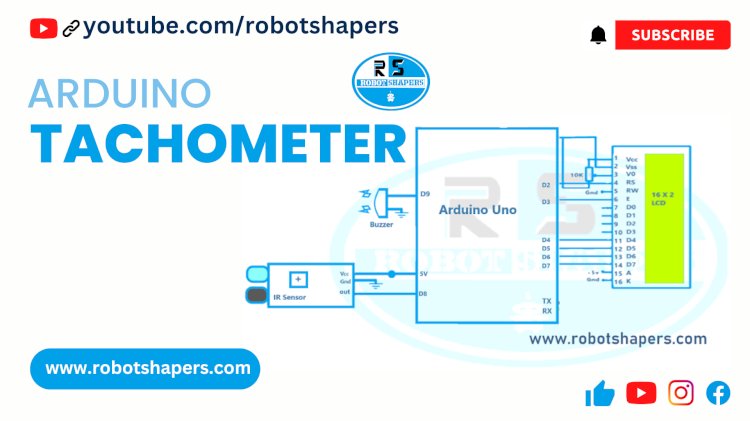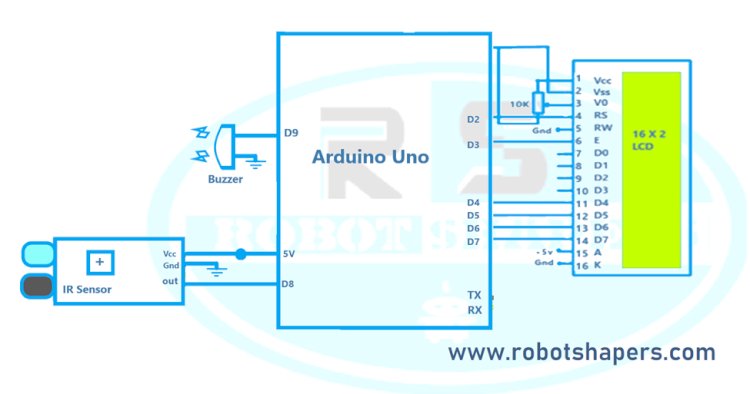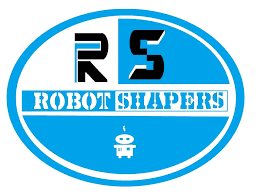Arduino Based Tachometer
"Unleashing Precision: Introducing Robotshapers' Arduino Based Tachometer" Introduction: Experience the power of precise measurements with Robotshapers' Arduino Based Tachometer. Our innovative device takes rotational speed monitoring to a whole new level, allowing you to accurately measure RPM and monitor the speed of various rotating machinery and equipment. Discover the diverse sensing methods, from optical and inductive sensors to Hall Effect technology, that enable our tachometer to detect rotation with exceptional precision.

Tachometer is a device used to measure the rotational speed or angular velocity of a rotating object. It is often used to measure the RPM (revolutions per minute) of an engine or generator, but can also be used to monitor the speed of other rotating machinery or equipment. The working principle of the Tachometer includes the following principles:
Sensing Methods: The tachometer uses various methods to measure rotational speed. Some methods include:
Optical Sensors: These sensors use light (like a flashlight).
, LEDs) and photodetectors to detect reflections or changes in light rays caused by rotating objects that are reflective or opaque.
Inductive Sensors: These sensors use the principle of electromagnetic induction. They have coils that create an electromagnetic field that causes a voltage change in the coil when a ferromagnetic target such as a glass or magnet passes.
Hall Effect Sensor: The Hall Effect sensor uses the phenomenon of Hall Effect, which causes a difference in resistance of a conductor when exposed to a magnetic field. Hall effect sensors can detect targets rotating with magnets or magnetic objects.
Contact Sensor: Contact tachometers use physical contact with a rotating shaft or gear to measure speed. The rotation causes the switch or electrical connections to make contact or break, causing a signal to be measured.
Function Problem: When the sensor detects rotation, the resulting signal is processed to determine the rotation speed. This function can include various techniques such as:
Pulse Count: The sensor generates a pulse for every full turn or part of a turn. The rotational speed can be calculated by counting the pulses in a given time.
Time Measurement: Measure the time it takes for a portion or a small portion of the rotation. The rotation speed can be determined by calculating the elapsed time.
Frequency Measurement: Measure the frequency of the signal generated by the sensor that corresponds to the rotation speed. This can be done using a digital counter or frequency-to-voltage converter.
Display and output: The speed measurement is displayed on the output interface of the tachometer.
Traditionally, tachometers used an analog display with a needle or dial to indicate RPM. However, modern tachometers often use digital displays such as LCD or LED for more accurate readings. There are also tachometers with output options such as analog voltage, current signal or digital communication for data input or integration with other systems.
Components Required:
Circuit diagram:

Code:
#define IR 8// IR Sensor pin
#define Buzzer 9
#include
int temp=0;
float rpm=0;
LiquidCrystal lcd(2,3,4,5,6,7);
void setup() {
Serial.begin(9600);
lcd.begin(16,2);
pinMode(IR,INPUT);
pinMode(Buzzer,OUTPUT);
}
void loop()
{
lcd.setCursor(0,0);
lcd.print("RPM -");
if( digitalRead(IR)==0)
{
temp++;
lcd.setCursor(0,0);
digital Write(Buzzer,LOW);
}
if( digitalRead(IR)==1)
{
digital Write(Buzzer,HIGH);
temp;
rpm=60000/(temp+300);
lcd.setCursor(10,0);
lcd.print(rpm);
Serial.print(rpm);
delay(300);
temp=0;
}
}
Applications:
- Tachometers are used in many areas such as automotive, industry and turbine fields.
- Cab speed is measured with a tachometer.
- Fan speed is measured with a tachometer.
- Speedometer of vehicles have tachometers.
Best proects in Bhilai, Chhattisgarh, India. Contact : 7067150002

 robotshapers1
robotshapers1 

















